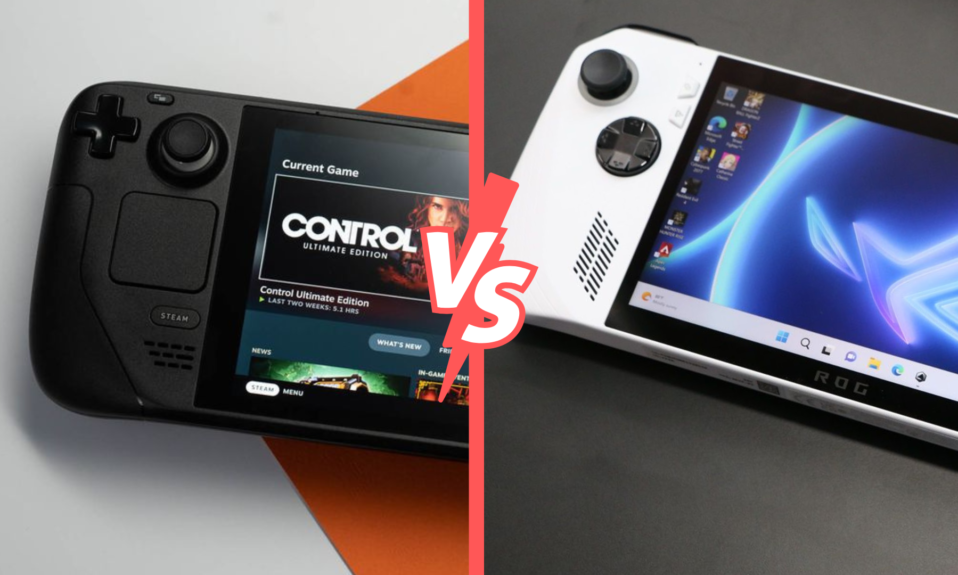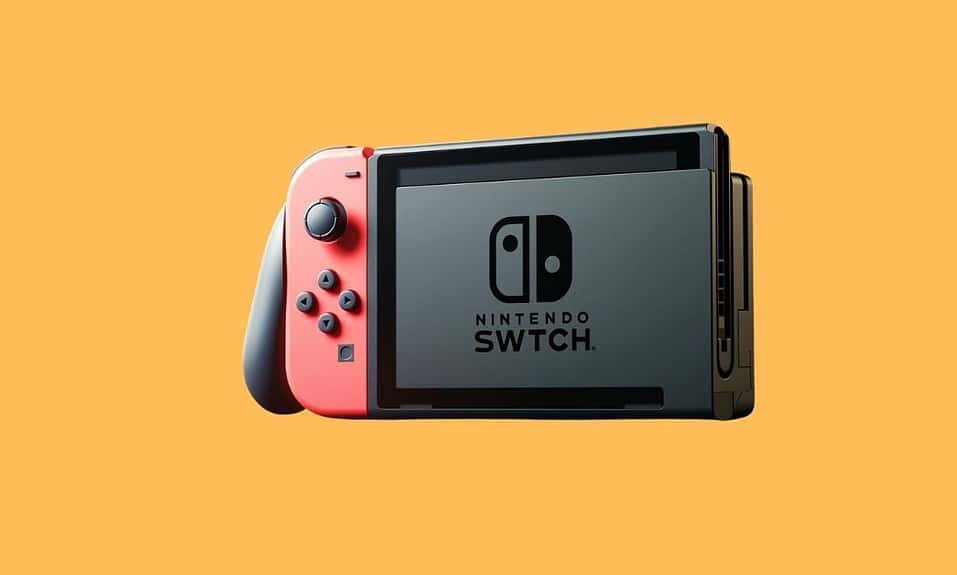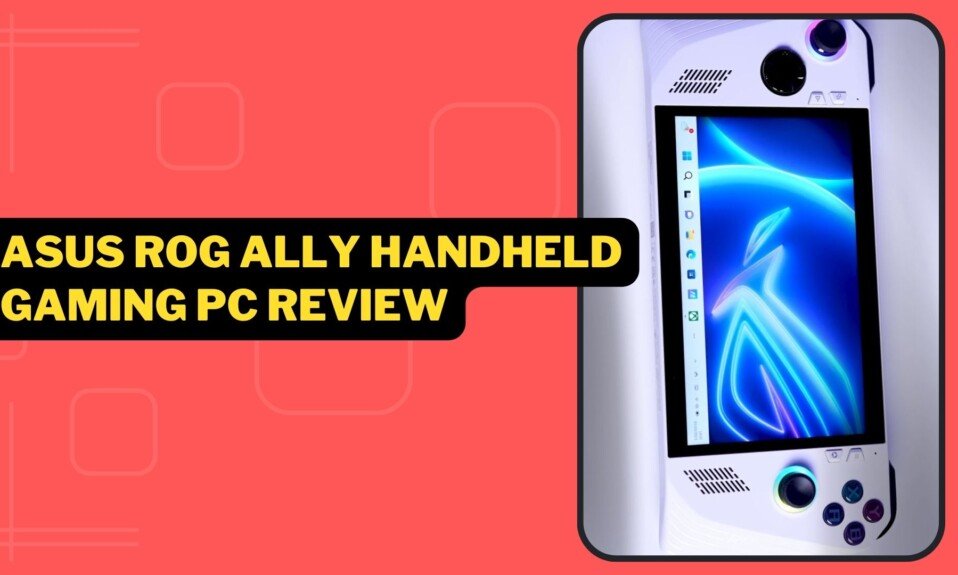Steam Deck vs Asus ROG Ally: The comparison between gaming consoles is heating up! Two popular players in this game are the Steam Deck and the Asus ROG Ally. Let’s dive in and compare these two. We’ll look at their design, specs, what system they run on, how long their batteries last, and how much they cost. Ready? Let’s go!
I spent a week testing the Z1 Extreme version of the ROG Ally. I’ll now break down its performance from various perspectives. Most importantly, I’ll compare it to the Steam Deck to show the difference in their capabilities. This should help you, especially if you’re trying to decide between the two. Let’s dive in!
Asus Rog Ally: Read Detailed Review
Specifications
| Steam Deck | Asus ROG Ally | |
|---|---|---|
| Brand | Valve | Asus |
| Dimensions | 298 x 117 x 49mm | 280 x 113 x 39mm |
| OS | Steam OS 3 | Windows 11 |
| Interface | User-friendly | Armory Crate SC |
| APU | AMD Van Gogh | Ryzen Zen 1 Extreme |
| CPU | 4 cores, 8 threads | 8 cores, 16 threads |
| GPU | RDNA2 IGP with 8 CEUs | RDNA 3i GPU with 12 CU |
| RAM | 16GB LP DDR5 | 16GB LP DDR5 |
| Display | 7-inch IPS, 60Hz | 7-inch IPS, 120Hz |
| Pixels | 1280×800 | 1920×1080 |
| Battery | 40 watt-hour | 40 watt-hour |
| Weight | 669 grams | 608 grams |
| Speakers | 2x front-facing | 2x front-facing, Dolby Atmos certification |
| USB ports | 1x USB-C with DisplayPort | 1x USB-C with DisplayPort |
| WiFi | WiFi 5 | WiFi 6E |
| Bluetooth | Bluetooth 5.0 | Bluetooth 5.2 |
| Fingerprint unlock | No | Yes |
Design and Portability
The Steam Deck and the Asus ROG Ally look pretty similar in design, but they have a small difference in weight. The Steam Deck tips the scales at 669 grams, and the Asus ROG Ally is a bit lighter at 608 grams. You might not be able to fit them in your pocket unless it’s super big. But, they’re still small enough to take with you for some fun gaming while you’re out and about.
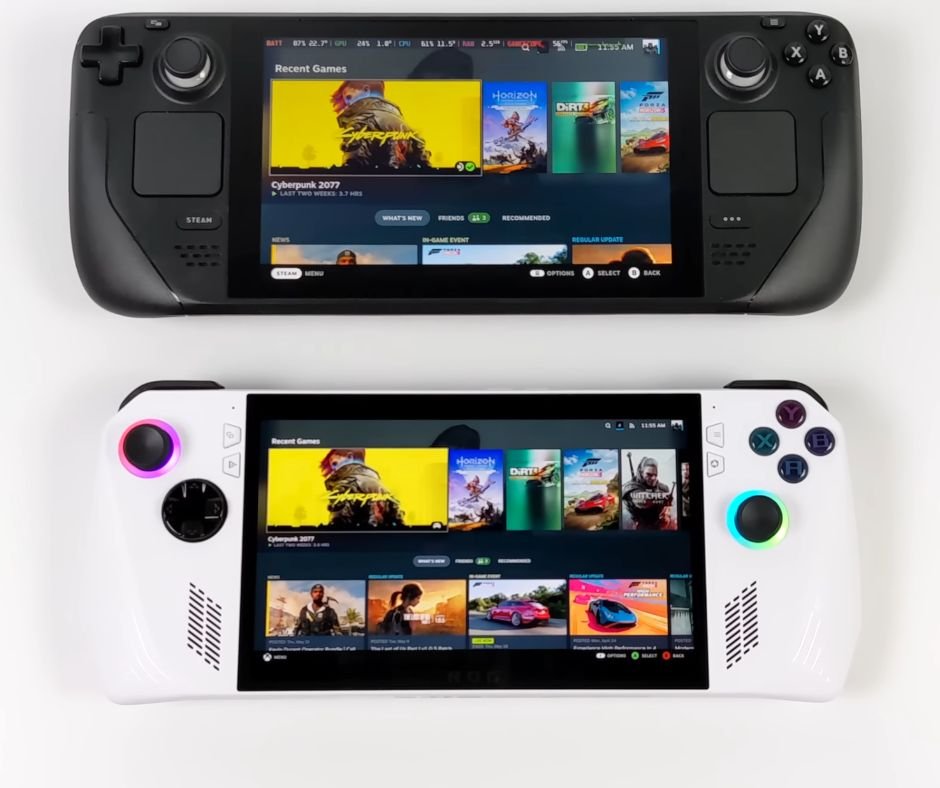
The Steam Deck has symmetrical touchpads that help players control their games better. On the other hand, the Asus ROG Ally has joysticks that are not at the same level: the right one is a bit lower, and the left one is a bit higher. Both the Steam Deck and the Asus ROG Ally have buttons that remind us of the Xbox. Some people might like the touchpads on the Steam Deck more, while others might find the special joystick placement on the Asus ROG Ally. Which one do you think is better?
Display and Audio
Both rivals opt for a 7-inch diagonal screen size, but they differ significantly in display characteristics. The Steam Deck boasts an HD resolution with a 16:10 aspect ratio, providing 400 nits of brightness and a 60Hz refresh rate. These specifications are decent for the console’s intended purpose.
On the other hand, the Asus ROG Ally triumphs with a Full HD 1920 by 1080 screen, a 16:9 aspect ratio, 120Hz refresh rate, and 500 nits of brightness. These features undoubtedly deliver a visually stunning gaming experience. However, it’s worth noting that the higher specifications on the Asus ROG Ally might impact game performance and battery life.
In terms of audio, both consoles offer stereo front speakers. However, the Asus ROG Ally stands out by providing virtual surround sound 5.1.2 and Dolby Atmos, enhancing the overall immersive gaming experience.
Performance and Operating System
When it comes to processing power, the Steam Deck utilizes an AMD Ryzen 2 processor with RDNA2 graphics. In contrast, the Asus ROG Ally offers two options: the AMD Ryzen Z1 and the Z1 Xtreme with C4 architecture and RDNA3 graphics. Both consoles feature 16GB LP DDR5 RAM. However, in terms of theoretical performance, the Asus ROG Ally outshines the Steam Deck with its impressive 8.6 teraflops in the Xtreme model, compared to the Steam Deck’s 1.6 teraflops. These specifications indicate a significant advantage for the Asus ROG Ally in synthetic tests and demanding gaming scenarios.
On the operating system front, the Steam Deck operates on SteamOS, which is a Linux-based system specifically designed for gaming and optimized for the Steam service. The interface provides a familiar experience for Steam users and offers compatibility with various services, albeit with occasional limitations and bugs. In contrast, the Asus ROG Ally runs on Windows 11, functioning more like a miniature laptop. This choice enables greater compatibility with streaming platforms, Xbox integration, and the ability to install Windows programs, making it a versatile gaming and productivity tool.
The ROG Ally has a cool program called Armory Crate. When you start the console, it shows you all the games you have and major game launchers. There’s also a special button on the left. When you press it, a menu pops up, letting players quickly change settings like resolution, refresh rate, and brightness. Some cool features that can affect how your game runs are the “Performance Mode” with options like Silent, Performance, and Extreme Speed. There’s also an “AMD RSR Upscaling” switch and a choice to set your screen’s FPS to 15, 30, or 60. If you don’t like how things are set up, you can dive deeper into the settings or customize the menu to make it just right for you.
Gaming Performance
| Game | Settings | ROG Ally (FPS) | Steam Deck (FPS) |
|---|---|---|---|
| Dirt 3 | 720p, Medium | 152 (avg), 105 (min) | 128 (avg), 96 (min) |
| Forza Horizon 5 | 720p, Low | 79 (avg) | 58 (avg) |
| Horizon Zero Dawn | 720p, FSR Perf | 83 (avg) | 65 (avg) |
| Cyberpunk 2077 | 720p, FSR Perf | 69 (avg), 13 (min) | 67 (avg), 29 (min) |
Note: All tests were conducted at a 15-watt TDP, representing the Steam Deck’s maximum power limit. The ROG Ally has higher wattage capabilities and may achieve better performance when configured to a higher TDP.
Battery Life
Battery performance is a crucial factor for portable gaming consoles. The Steam Deck consumes between 5 and 15 watts, while the Asus ROG Ally ranges between 7 and 30 watts in Turbo mode. Although the latter delivers a superior gaming experience, the battery drains significantly faster, resulting in an hour of gameplay. In normal mode, both consoles offer nearly 2 hours of gameplay for AAA titles. However, when limiting the resolution and frame rate, the Steam Deck manages to provide slightly longer battery life than the Asus ROG Ally. Furthermore, if you utilize the consoles for other purposes, such as video playback or productivity tasks, both devices can last up to 5 to 6 hours respectively.
Pricing
When it comes to pricing, there are several factors to consider. The Steam Deck offers a more affordable option in its basic configuration. However, if you require more storage, the price rises to 649 dollars for the 512GB model.
On the other hand, the Asus ROG Ally starts at a similar price point of $699 for the Z1 configuration, and for an additional 20 dollars, you can obtain the Z1 Xtreme model. Both versions of the Asus console provide 512GB of storage.
Additionally, it’s worth mentioning that both consoles support expandable storage through Micro SD cards, with the Steam Deck utilizing a standard or HS1 format and the Asus ROG Ally supporting UHS2.
| $ | |
| ASUS ROG Ally 512GB Model | $699 |
| Steam Deck 64GB Model | $399 |
| Steam Deck 256GB Model | $529 |
| Steam Deck 512GB Model | $649 |
Differences
Operating System: The ROG Ally runs Windows 11, while the Steam Deck runs Steam OS, which is a version of Linux.
Variants: The ROG Ally is available in two different variants, but no specific details are mentioned in the reference article.
Trackpads: The Steam Deck has trackpads, whereas the ROG Ally does not.
Display: The ROG Ally features a 16:9 aspect ratio 1080p display, while the Steam Deck has a 16:10 aspect ratio 800p panel, despite having the same screen size.
Size: The ROG Ally is slightly smaller than the Steam Deck.
Refresh Rate: The ROG Ally has a refresh rate of 120Hz, whereas the Steam Deck has a refresh rate of 60Hz.
Price: The base model of the Steam Deck is priced at $399, while the ROG Ally starts at $599.
APU (Accelerated Processing Unit): All models of the Steam Deck have the same APU.
Weight: The ROG Ally weighs 608 grams, while the Steam Deck weighs 669 grams.
Lighting: The ROG Ally features RGB lighting, whereas the Steam Deck does not. Additionally, the ROG Ally is available in white, while the Steam Deck only comes in black.
Battery Life: At a 15-watt TDP, both devices offer similar battery life, with the Steam Deck providing around 103 minutes and the ROG Ally offering approximately 96 minutes. However, the Steam Deck can potentially achieve better battery life by lowering the TDP for less demanding games.
Charging: The ROG Ally comes with a 65-watt PD quick charger, enabling faster charging times. It takes about 1.4 hours to fully charge the Ally, while the Steam Deck’s 45-watt charger requires around 3.3 hours.
Feel and Functionality: Steam Deck vs Asus ROG Ally

The ROG Ally and Steam Deck look and feel different because of their sizes, buttons, and features. The ROG Ally has a simple design made for easy gaming. It uses a regular button layout. If you need to move the mouse in Windows mode, you either use the right joystick or touch the screen. The handles of the ROG Ally are closer to the main body, and they curve nicely. For someone with smaller hands like mine, it’s comfortable to hold. All the buttons feel right where they should be. Plus, your middle finger naturally rests on a button at the back, which makes playing even more intuitive and feels great!

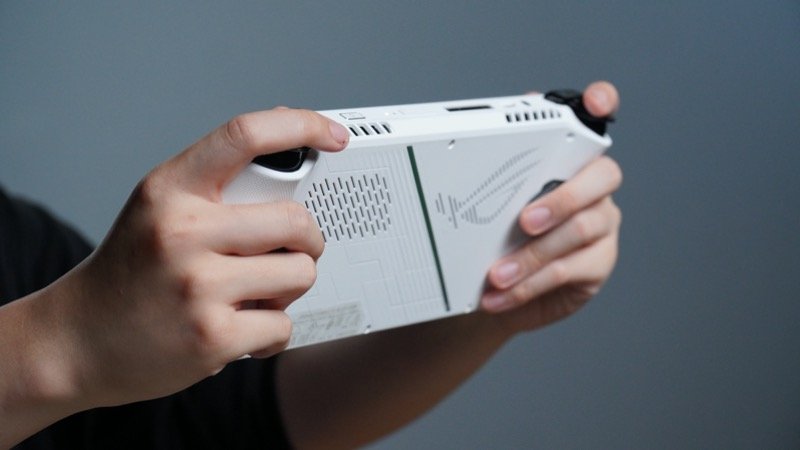

The Steam Deck is designed to give players a computer-like feel on a console. It’s friendly for both left- and right-handed players. How? It has a matching layout with touchpads below the buttons on both sides. These touchpads act like a mouse. Compared to the ROG Ally, the Steam Deck makes it easier to play games that need both touchpad and touchscreen inputs. Plus, it has a cool feature where you can tilt the console to aim, just like the Nintendo Switch. This can be more accurate than just using a joystick or touchpad. However, because of all these features, the button layout on the Steam Deck is different from what we’re used to. It might take a bit of time to get the hang of it.



The Steam Deck’s design makes its handle pretty wide. This can be tricky for some players, especially those with smaller hands, to hold comfortably. Also, the L1 and R1 buttons, which gamers use a lot, don’t stick out much. So, if you’re holding the L2 and R2 buttons, your fingers might feel a bit weird and uncomfortable.
On the other hand, the ROG Ally has a more traditional feel. So, if you prefer a more classic game console that’s just about pushing buttons, the comfy ROG Ally might be a better pick for you. But if you’re looking for a gaming experience that feels more interactive, the Steam Deck could be your choice.
Both consoles have their strengths and weaknesses. It really depends on what you’re looking for in a gaming experience!
Pros and Cons
| Asus ROG Ally | Valve Steam Deck | |
|---|---|---|
| Performance | Higher FPS in tested games at 15-watt TDP | Slightly lower FPS in tested games at 15-watt TDP |
| Display | 120 Hz IPS display | 60 Hz IPS display |
| Battery Life | Slightly shorter battery life | Slightly longer battery life |
| Power Management | Less efficient power management system | Efficient power management system |
| Operating System | Windows 11 | SteamOS 3 |
| User Interface | Armory Crate SC, built-in game launcher | Big Picture Mode (SteamOS) |
| Emulation Capability | Second to none with the Z1 Extreme processor | Good emulation capability |
| Weight | Lighter at 608 grams | Heavier at 669 grams |
| Upgradability | Upgradable storage | Upgradable storage |
| Availability | Launched in June 2023 | Available for over a year |
Conclusion!
In summary, the Steam Deck offers a positive and user-friendly interface, with notable features such as configurable rear buttons, symmetrical touchpads, and durable joysticks. On the other hand, the Asus ROG Ally excels in terms of performance, boasting a superior screen, compatibility with a wide range of games, and the versatility of the Windows 11 operating system.
Ultimately, the choice between the Steam Deck and the Asus ROG Ally depends on individual preferences and priorities. If you prioritize a seamless gaming experience, precise controls, and a budget-friendly option, the Steam Deck may be the ideal choice for you. However, if you seek top-notch performance, immersive visuals, and extensive compatibility, the Asus ROG Ally emerges as a formidable contender. The ball is now in your court to decide which console best suits your gaming needs.
